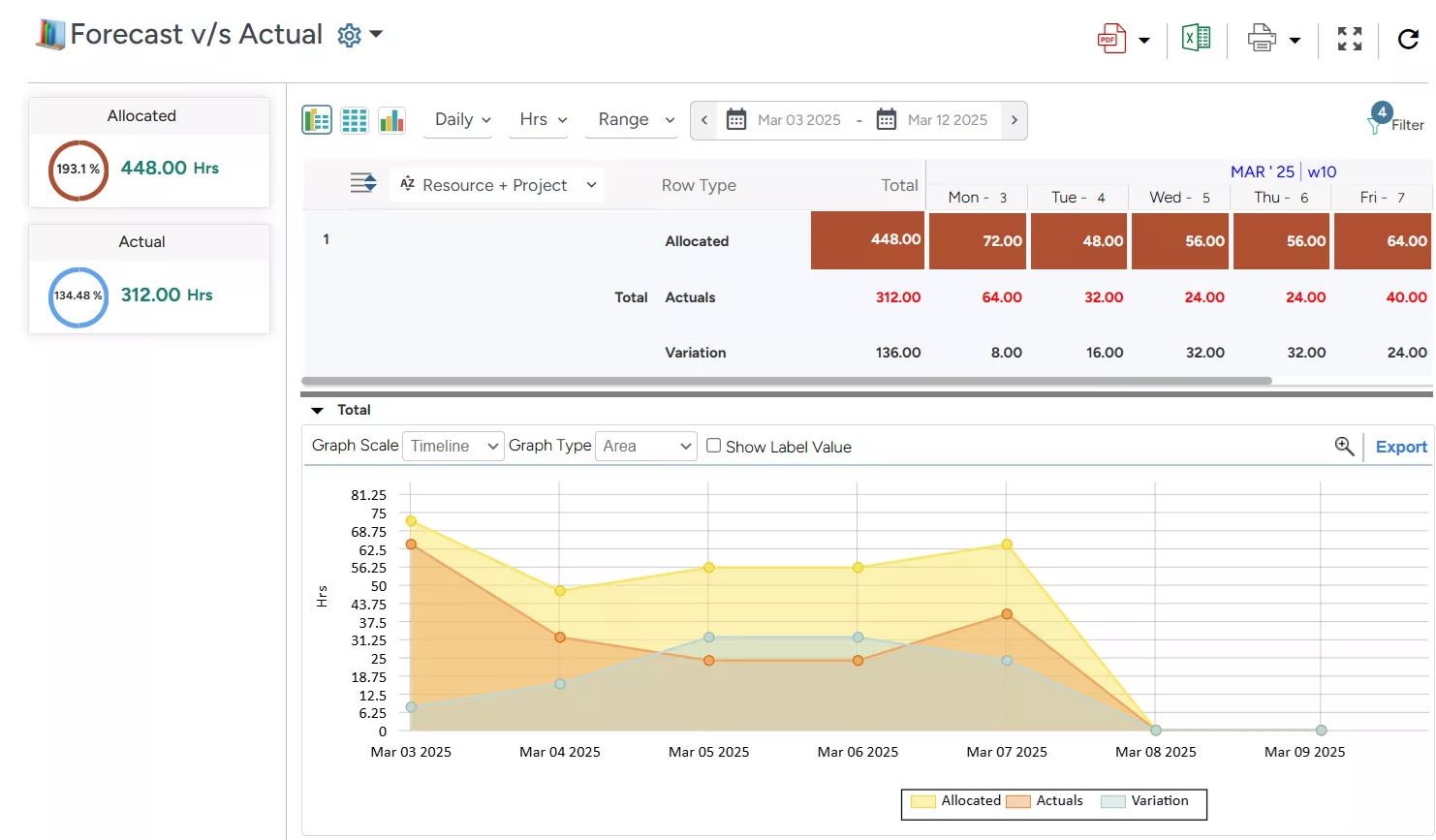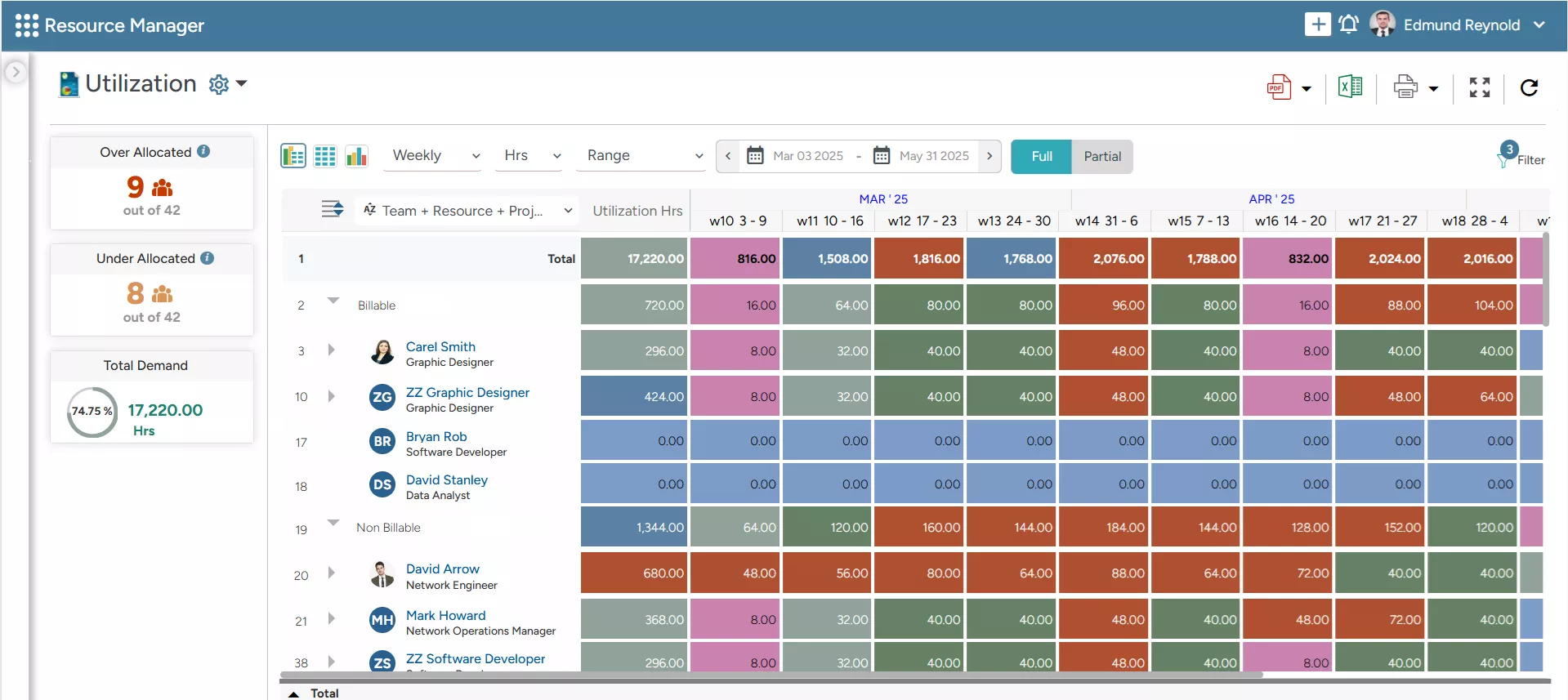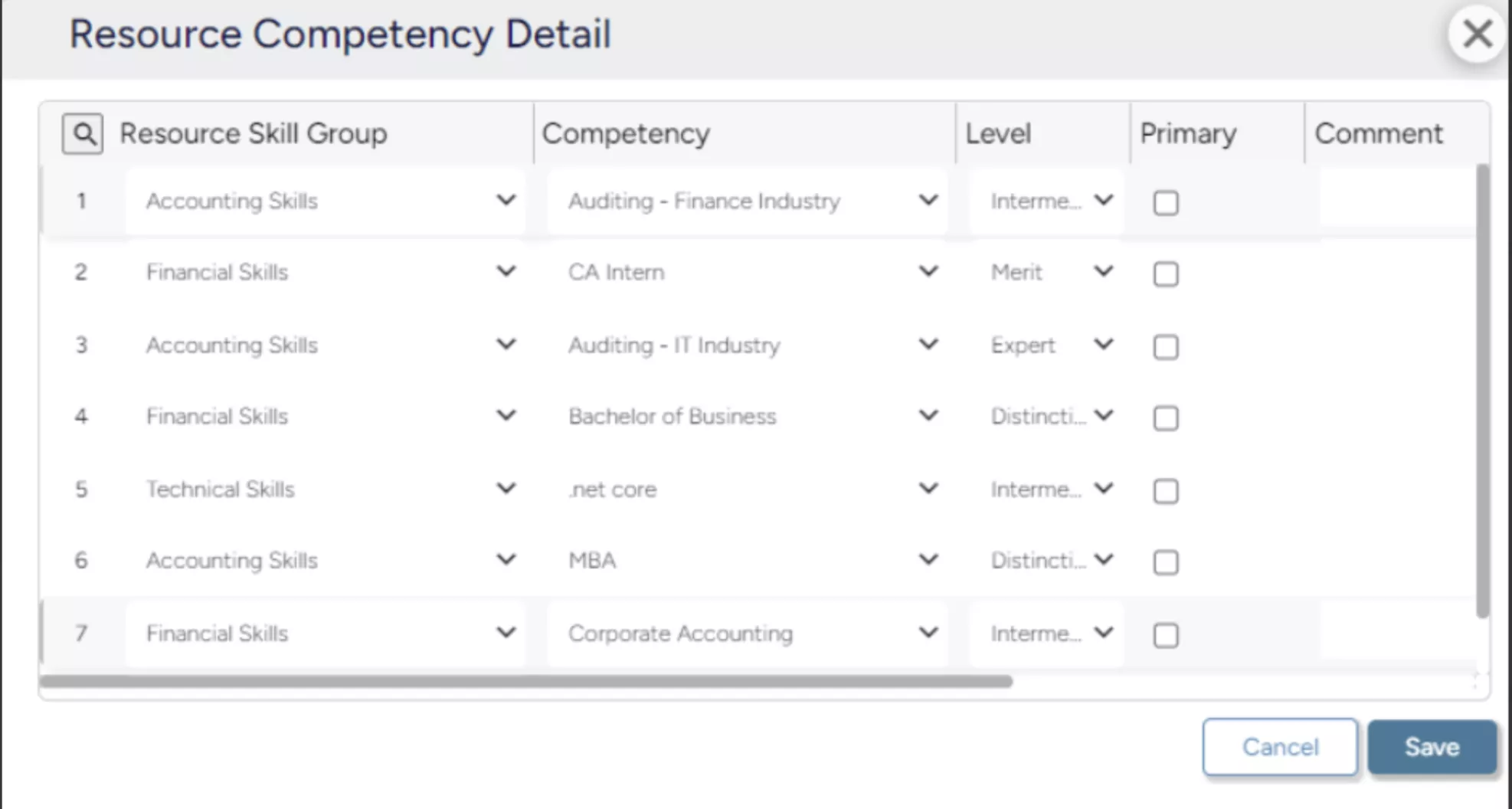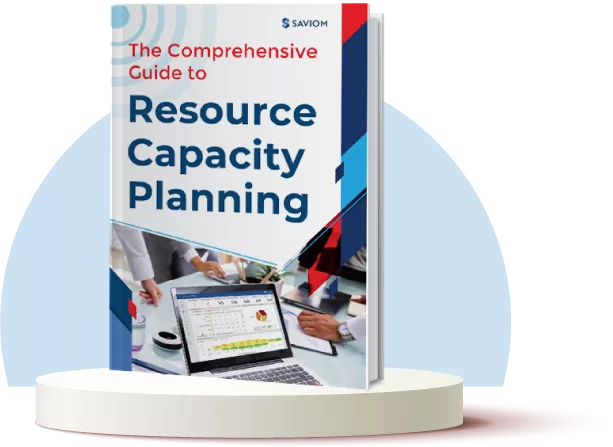Introduction
In project-based organizations, monitoring and optimizing resource performance is key to meeting delivery goals. However, in the absence of centralized tracking facilities and clearly defined benchmarks, project and resource managers often rely on guesswork and gut instincts to manage the workforce.
Consequently, this unstructured approach leads to multi-pronged issues such as overutilization, capacity wastage, skill mismatches, budget overruns, and delayed deliveries. That’s why tracking resource management KPIs (Key Performance Indicators) is indispensable.
These quantifiable metrics provide actionable insights into how effectively resources are being allocated, utilized, and aligned with business goals. They help organizations to identify potential workforce constraints, make data-driven decisions, and continuously refine their resource planning practices.
In this blog, we will delve deeper into the 15 key resource management metrics that facilitate informed decision-making, optimize employee performance, and drive project profitability.
Let’s dive in.
15 Resource Management KPIs You Must Track
The following are the top resource management KPIs every manager should monitor to enhance employee performance, keep projects on schedule, and drive overall business profitability:
Resource Utilization Rate
The resource utilization rate is one of the critical resource management metrics that measures the percentage of a resource’s available time spent on productive, value-adding tasks. It helps organizations evaluate how effectively the resources are utilized against their total capacity. As a result, this facilitates balanced workloads while preventing instances of over- or under-allocation.
For instance, a high utilization rate often indicates heavy workloads, which can result in employee burnout if not effectively managed. Contrarily, a low rate can signal underutilization of resources or mismatches between available skills. By regularly tracking this metric, managers can ensure that the right talent is assigned to high-impact tasks, ultimately boosting productivity and enhancing overall profitability.
The formula to calculate the resource utilization rate is:
For example, if a resource logs 32 hours out of 40 available hours in a week, their utilization rate would be:
Resource Utilization Rate (%) = (32 / 40) × 100 = 80%
Resource Forecast Accuracy
Resource forecast accuracy refers to the degree to which an organization’s predicted resource demand aligns with the actual resources required. It serves as a key indicator of the reliability of the resource planning process, enabling managers to assess performance and identify areas that require course correction.
High forecast accuracy reduces last-minute hiring and allocation bottlenecks. It also helps avoid reactive decisions that often lead to cost overruns or project delays. Consistent improvements in demand forecast accuracy demonstrate the maturity of an organization’s resource planning practices and highlight its ability to respond swiftly to shifting demands.
Here is the formula to calculate resource forecast accuracy:
For example, if the forecasted demand for a construction project was 90 resources but the actual demand turned out to be 100, the forecast accuracy would be:
Resource Forecast Accuracy (%) = (1 – |90 − 100| / 100) × 100 = (1 – 10 / 100) × 100 = 90%
Expand your knowledge: What is Resource Forecasting? An Ultimate Guide
Resource Availability Rate
Resource availability rate is the percentage of time a resource (human or non-human) is available to perform productive work within a specific timeframe. It quantifies the portion of a resource’s total capacity that can be assigned to tasks, taking into account current commitments, scheduled leave, maintenance, and other organizational constraints.
A high availability rate indicates that resources have sufficient capacity and can be assigned to productive, billable work. Conversely, a low availability rate may indicate that the resource is already engaged in other work or that overall capacity is limited due to talent shortages. Therefore, tracking this metric is crucial for project planning and delivery, as it helps prevent overbooking, resource shortages, and inefficiencies.
Suppose a senior software engineer has a total monthly capacity of 160 hours, but due to prior allocation, only 120 hours are available for project work. The availability rate would be:
Resource Availability Rate = (120 / 160) × 100 = 75%
Billable vs. Non-Billable Hours
Billable vs. non-billable hours is another critical KPI that shows how effectively an organization utilizes its workforce’s time between revenue-generating work and non-billable activities. Billable hours represent client-facing tasks that directly generate revenue. In contrast, non-billable hours include activities such as training, internal meetings, or administrative work that cannot be charged to the client.
By monitoring billable and non-billable hours, managers can gain a clear picture of overall resource utilization levels and address inefficiencies more effectively. Consequently, this helps firms maximize profitable resource utilization, improve overall billability, and drive business profitability.
For instance, consider a consultant who worked 160 hours in a month, with 120 hours spent on client projects (billable) and 40 hours on training and internal meetings (non-billable).
Using the formulas:
Billable Hours % = (120 / 160) × 100 = 75%
Non-Billable Hours % = (40 / 160) × 100 = 25%
Billable vs. Non-billable Hours= 120 / 40 = 3
This highlights that the consultant spent three times more effort on revenue-generating work than on overhead tasks.
Take a quick look at this infographic: 7 Key Strategies to Improve the Billability of an Organization
Resource Allocation Effectiveness
Resource allocation effectiveness calculates how appropriately an organization assigns its available resources, such as people, equipment, and finances, to tasks and projects to achieve optimal results with minimal waste. It indicates whether resources are deployed to the most suitable activities at the right time and the right cost. Moreover, effective allocation ensures resources are neither overburdened nor underutilized.
A high allocation effectiveness score indicates that resources are being used optimally to maximize productivity and minimize bench time. Conversely, a low effectiveness rate may signal misaligned priorities, bottlenecks, or underutilization of assets. Regularly tracking this metric helps firms address demand fluctuations, avoid skill shortages, and make data-driven decisions to optimize resource allocations in real-time.
For example, if a marketing firm allocated 120 hours to a campaign and the team effectively utilized 110 hours for productive work, the allocation effectiveness would be:
Resource Allocation Effectiveness = (110 / 120) × 100 = 91.67%
Revenue Per Resource
Revenue per resource is another one of the vital KPIs that measures the amount of revenue generated by each resource within a specific timeframe. It provides valuable insight into how effectively the organization leverages its workforce to achieve business goals and drive profitability. This metric is also useful for monitoring performance trends over time and benchmarking against industry standards.
A higher revenue per resource typically indicates greater employee productivity and improved operational efficiency. Conversely, a lower revenue per resource typically indicates reduced employee productivity or inefficient use of available skills and capacity. Additionally, it may suggest poor project margins, misaligned roles, or underutilization of talent.
For instance, if a digital marketing agency earns $600,000 in a quarter with a team of 25 marketers, the revenue per resource would be:
Revenue Per Resource Per Quarter = $600,000 / 25 = $24,000
Forecast vs. Actual Time
Forecast vs. actual time compares the estimated hours a resource is expected to spend on assigned work with the actual hours recorded. This metric enables managers to evaluate the accuracy of planned work hours in relation to actual hours worked, identify discrepancies, and take corrective actions to bridge the gap.
Moreover, tracking forecast vs. actual time enables organizations to improve demand forecasting, avoid under- or overallocation of resources, and enhance operational efficiency. A small variance indicates that planned and actual hours closely match, while a significant variance may suggest inefficiencies, unexpected delays, or inaccurate estimates.
For example, if a UX designer was forecasted to spend 50 hours on a website redesign but actually spent 60 hours, the variance would be:
Forecast vs. Actual Time Variance = (50 − 60) / 50 × 100 = (−10 / 50) × 100 = −20%
(A negative variance indicates the task took 20% more time than planned.)
 SAVIOM’s Forecast vs. Actual Report highlights estimated vs. actual time spent on tasks, helping managers identify variances and take corrective action.
SAVIOM’s Forecast vs. Actual Report highlights estimated vs. actual time spent on tasks, helping managers identify variances and take corrective action.
Resource Turnover Rate
The resource turnover rate measures the frequency at which employees or other resources leave an organization and are replaced within a specified period. It is typically shown as a percentage and provides critical insight into workforce stability and retention. Monitoring this metric enables firms to proactively identify retention challenges, enhance resource planning, and maintain team consistency.
A high turnover rate can signal underlying issues such as employee burnout, a lack of growth opportunities, or poor morale. On the other hand, a low rate generally suggests strong employee engagement and organizational health. By regularly tracking turnover, companies can take timely action to improve retention rates and support long-term workforce planning.
For example, if a mid-sized IT firm had 12 employees leave over a year and maintained an average workforce of 150 during that time, the turnover rate would be:
Resource Turnover Rate Per Year = (12 / 150) × 100 = 8%
Find out more: Top 11 Employee Retention KPIs Businesses Should Track
Strategic Utilization
Strategic utilization is a key KPI that measures the proportion of a resource’s time dedicated to long-term strategic initiatives that align with the organization’s long-term, strategic projects. By tracking this metric, firms can gain clarity on how effectively their existing talent is being utilized toward projects that drive innovation or market expansion.
In case of discrepancies, managers can take actionable steps to adjust resource allocations, ensuring that critical personnel are invested in initiatives that matter most for the company’s future, such as digital transformation and product innovation. Maintaining an optimal level of strategic utilization ensures the workforce is actively contributing to the organization’s long-term growth.
For instance, if a consultant spends 20 hours on strategic projects out of 40 total available hours in a week, their strategic utilization would be:
Strategic Utilization (%) = (20 / 40) × 100 = 50%
Billable Utilization
Billable utilization is another vital KPI that measures the percentage of an employee’s total available hours dedicated to billable, client-focused tasks. This metric highlights how effectively resources are contributing to revenue generation and overall business profitability. When discrepancies arise, firms can intervene promptly to enhance billability and protect profit margins.
A higher billable utilization rate indicates that the resources are spending most of their capacity on billable, revenue-generating work. Contrarily, a lower rate suggests that resources are spending a significant amount of time on non-billable activities. Hence, by accurately tracking this key performance indicator, managers can identify imbalances, optimize productive resource utilization, and secure healthy profit margins.
For instance, if a consultant spends 30 hours on billable tasks out of 40 available hours in a week, their billable utilization would be:
Billable Utilization (%) = (30 / 40) × 100 = 75%
Explore further: Billable Hours: Key Benefits & Strategies to Optimize Them
 SAVIOM’s Color-Coded Heatmap highlights the utilization levels of every resource, enabling managers to identify imbalances and optimize productive utilization.
SAVIOM’s Color-Coded Heatmap highlights the utilization levels of every resource, enabling managers to identify imbalances and optimize productive utilization.
Productive Utilization
Productive utilization evaluates how productively resources are allocated and utilized across billable, strategic, and other high-value projects. It ensures employees are engaged in activities that drive immediate financial returns and long-term business impact.
By tracking this KPI, firms can prevent talent from being tied up in low-value, non-billable tasks and instead channel effort toward opportunities that matter most. This helps firms maximize workforce productivity, boost business profitability, and maintain a competitive edge.
For instance, if a consultant spends 15 hours on billable tasks, 10 hours on strategic initiatives, and 5 hours on other high-value projects out of 40 total available hours in a week, their effective utilization would be:
Productive Utilization (%) = [(15 + 10 + 5) ÷ 40] × 100 = [30 ÷ 40] × 100 = 75%
This highlights that the consultant devoted a large percentage of weekly capacity to billable, strategic, or high-value work.
Resource Cost Variance
Resource cost variance measures the difference between the budgeted resource cost and the actual cost incurred over a specific period. It provides organizations with clear visibility into whether projects are being executed within budget or drifting into cost overruns.
For instance, a positive variance indicates that the project is within the budget, while a negative variance signals that actual costs have exceeded the budgeted value, impacting project profitability. By tracking this metric, managers can improve resource cost forecasting accuracy, make better allocation decisions, and keep projects within budget.
For instance, if the budgeted resource cost for a project is $10,000, but the actual cost incurred is $8,500, the variance would be:
Resource Cost Variance = 10,000 − 8,500 = +1,500
Discover related insights: 6 Resource Cost Reduction Strategies for Modern Businesses
Cost Per Resource Unit
Cost per resource unit is a vital KPI that calculates the overall expense of utilizing one unit of a resource’s time, such as an hour, day, or month. It combines both fixed costs, like salaries and benefits, along with variable costs, like training, equipment, and overheads.
By tracking this key performance indicator, firms gain clarity on the actual cost of deploying resources, making financial planning more transparent and precise. It also helps managers ensure that resource costs remain within the project budget, preventing budget overruns and safeguarding business profitability.
For instance, if the total resource cost for an employee in a week is $3,000 and the total resource units (hours) worked during that week are 40, then the calculation would be:
Cost Per Resource Unit = 3,000 / 40 = $75 per hour
Cost Per Hiring Resource
Cost per hiring resource is a key recruitment metric that evaluates the total cost an organization incurs to hire a new employee. It combines external expenses such as job advertisements, agency fees, and job portal charges with internal costs like recruiter salaries, interview hours, and onboarding activities. Understanding this metric enables firms to make more strategic decisions when investing in recruitment efforts.
Furthermore, this performance indicator helps organizations assess the efficiency of their recruitment process and identify cost drivers. Accordingly, businesses can take necessary measures to reduce unnecessary expenses without compromising the quality of hires, ensuring sustainable talent acquisition.
For instance, if an organization spends $350,000 on recruiting and onboarding costs in a quarter and makes 10 new hires during that period, the calculation would be:
Cost Per Hiring Resource = 350,000 / 10 = $35,000 per hire
Keep reading: Talent Acquisition Strategy: What it is & How to Build One?
Skill Gap Index
The skill gap index measures the difference between the skills an organization needs to deliver existing and future projects and the current capabilities of its workforce. It helps identify critical roles or specialized skills that are in short supply, which may jeopardize project delivery, lower quality standards, or impact overall productivity.
A high skill gap index signals significant shortages in essential roles, whereas a lower index indicates more substantial alignment between workforce demand and available talent. Tracking this KPI enables managers to take proactive steps such as targeted hiring, employee upskilling, or cross-training programs. Ultimately, this KPI supports the development of a resilient, future-ready workforce that helps an organization achieve its long-term goals.
For instance, if a project requires 20 specific skills but the current workforce has only 15 of that expertise, the calculation would be:
Skill Gap Index = [(20 − 15) ÷ 20] × 100 = (5 ÷ 20) × 100 = 25%
 SAVIOM’s Competency Matrix provides visibility into existing skills across the organization, allowing managers to identify skill gaps and initiate targeted training and upskilling programs.
SAVIOM’s Competency Matrix provides visibility into existing skills across the organization, allowing managers to identify skill gaps and initiate targeted training and upskilling programs.
Having understood the critical resource management KPIs, let’s explore how a 5th-gen resource management solution can help track these metrics seamlessly.
Advance Resource Management Maturity with SAVIOM
Here’s how SAVIOM empowers organizations to elevate resource management maturity.
Most Advanced Resource Management Solution
In today’s volatile market, businesses must deliver more with fewer resources while staying profitable and sustainable. SAVIOM’s advanced resource management solution empowers firms to achieve this by providing real-time visibility into critical KPIs such as overall resource utilization, billable utilization, strategic utilization, billable vs. non-billable hours, forecast vs. actual time, and more. With these insights, organizations can maximize resource efficiency, control costs, and maintain a competitive edge.
Highly Configurable and Scalable Tool
Every organization operates differently, with distinct workflows, approval hierarchies, and reporting requirements, making rigid, one-size-fits-all systems ineffective. Thus, modern businesses need a flexible resource management solution like SAVIOM that is built with high configurability and can be customized to their unique needs. Moreover, its scalable architecture ensures the system grows effortlessly with expanding teams, projects, and data volumes.
Dive deeper: How to Select Resource Management Software for Your Firm?
5th Gen Resource Management Maturity Capabilities
SAVIOM’s 5th-generation resource management solution is built to tackle the evolving challenges of modern enterprises. It offers advanced features like multi-dimensional forecasting, dynamic capacity planning, real-time allocation, continuous optimization, and scenario modeling. By leveraging these features, businesses can accelerate their resource management maturity, boost resource utilization, build greater resilience, and stay ahead of the competition.
Market Leader in the Resource Management Domain
SAVIOM stands as a global pioneer in enterprise resource management, trusted by Fortune 500 companies and industry leaders like Honeywell, Fujitsu, ABB, Siemens, and FTI Consulting. Our solutions are used in 50+ countries across industries to optimize resources, streamline project delivery, and drive business success. With over two decades of expertise, SAVIOM’s next-gen software continues to shape the future of resource management.
Continue reading how SAVIOM ERM Helps FTI Consulting Schedule More Than 200 Employees Efficiently.
Achieve a Higher Return on Investment
SAVIOM’s advanced forecasting and capacity planning help organizations identify resource gaps early and avoid expensive last-minute staffing. It ensures the right people are assigned to the right projects by analyzing cost, availability, and skills. Additionally, automated resource requisition and approval workflows reduce administrative overhead. As a result, SAVIOM’s next-gen resource management solution empowers businesses to maximize utilization, optimize project delivery, and achieve a higher ROI.
Conclusion
Resource management KPIs provide organizations with the clarity needed to measure efficiency, optimize allocation, and align resources with business goals. By regularly tracking these metrics, firms can identify gaps, prevent inefficiencies, and make data-driven decisions that enhance productivity and profitability. Ultimately, effective use of KPIs transforms resource management from a reactive process into a strategic advantage, ensuring sustainable growth and long-term success.










